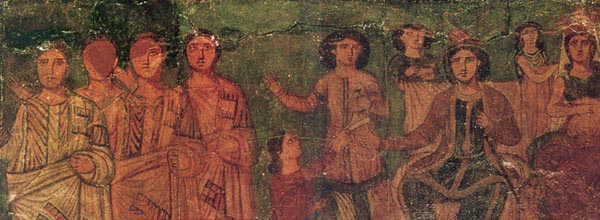Image Details

Photo courtesy of the Department of Antiquities, Syria
A royal portrait of the Persian king Ahasuerus and his Jewish wife Queen Esther enlivens one of the panels of the famous western wall of the third-century C.E. Dura-Europos synagogue in modern Syria. Four unidentified men (together they have only seven feet) stand to the left of the king, who sits on an elaborate throne approached by steps decorated with golden eagles and lions. According to a tradition preserved in Targum Esther, a rabbinical commentary on the biblical book, Ahasuerus sat on King Solomon’s throne. The Dura painting reflects the biblical description of six steps leading up to the throne and two lions standing beside its arms (1 Kings 10:19). But it also differs: While the Bible mentions paired lions on each step of Solomon’s throne, the painting alternates lions with eagles.
The Dura-Europos artists, like the seventh-century B.C.E. editors of the Book of Kings, apparently found art works depicting humans and animals acceptable, despite the biblical prohibition “You shall not make any idol or any type of graven image” (Exodus 20:4). While this commandment has led some to ban all figural art work, many Jewish authorities have interpreted the passage as dependent on the laws “You shall not bow down to them or worship them” (Exodus 20:5) and “You shall have no other gods besides me” (Exodus 20:3): Thus, images are prohibited only if they represent other gods and are deified. In certain ages, however, Jews have interpreted these laws more narrowly to prevent images from becoming objects of worship.
